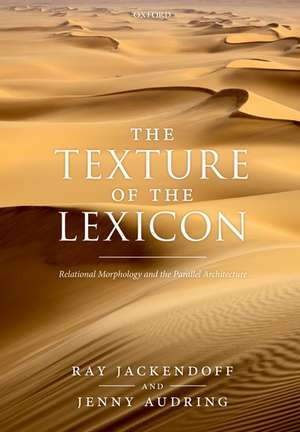The Texture of the Lexicon: Relational Morphology and the Parallel Architecture
Autor Ray Jackendoff, Jenny Audringen Limba Engleză Paperback – 28 oct 2021
| Toate formatele și edițiile | Preț | Express |
|---|---|---|
| Paperback (1) | 164.24 lei 10-17 zile | +44.98 lei 7-13 zile |
| OUP OXFORD – 28 oct 2021 | 164.24 lei 10-17 zile | +44.98 lei 7-13 zile |
| Hardback (1) | 436.56 lei 3-5 săpt. | +29.65 lei 7-13 zile |
| OUP OXFORD – 24 dec 2019 | 436.56 lei 3-5 săpt. | +29.65 lei 7-13 zile |
Preț: 164.24 lei
Preț vechi: 186.92 lei
-12% Nou
Puncte Express: 246
Preț estimativ în valută:
31.43€ • 32.81$ • 26.01£
31.43€ • 32.81$ • 26.01£
Carte disponibilă
Livrare economică 03-10 martie
Livrare express 28 februarie-06 martie pentru 54.97 lei
Preluare comenzi: 021 569.72.76
Specificații
ISBN-13: 9780198827917
ISBN-10: 0198827911
Pagini: 384
Dimensiuni: 173 x 247 x 18 mm
Greutate: 0.58 kg
Editura: OUP OXFORD
Colecția OUP Oxford
Locul publicării:Oxford, United Kingdom
ISBN-10: 0198827911
Pagini: 384
Dimensiuni: 173 x 247 x 18 mm
Greutate: 0.58 kg
Editura: OUP OXFORD
Colecția OUP Oxford
Locul publicării:Oxford, United Kingdom
Recenzii
The Texture of the Lexicon is a reader-friendly introduction to the framework of Relational Morphology that complements the Parallel Architecture approach. I believe that readers interested in morphology at large will find something interesting in this read.
Review from previous edition This is the best linguistics book of 2020: A comprehensive view of morphological patterns that does not struggle with, but comfortably explains, the frequently observed continuity between regular grammatical patterns and memorized/idiosyncratic forms.
Through extending Jackendoff's Parallel Architecture by a sophisticated system of co-indexing, the authors develop a surprising perspective on language as a whole. They overcome the separation of grammar and lexicon, the contrast of regular and idiosyncratic items, of productive and unproductive patterns, of core and periphery. Relational Morphology brings with it a new and exciting picture of language as an integrated mental capacity.
Jackendoff and Audring unravel the illusory divide between the lexicon and grammar to weave together, with enduring insights, a vast range of semi-regular and fully engaging phenomena.
Jackendoff and Audring combine the models of Parallel Architecture and Construction Morphology to propose an innovative perspective on the lexicon, morphology, phonology, syntax, semantics, and their interaction, centered around their simple, but far-reaching, Relational Hypothesis: all types of linguistic relatedness can be coded as static relational schemas over fully listed items, but a subset of those schemas also serve as productive, generative devices. The authors' wide-ranging exploration lays down the gauntlet for competing models.
This is a lovely book that elaborates the elegant and simple functional linguistic perspective of Jackendoff's (2002) "Parallel Architecture" research program into a detailed attempt to explain what lexical items are. The answer that Jackendoff and Audring arrive at is surprising: there is no principled distinction between grammar and lexicon, contrary to what has standardly been assumed. There is a wealth of fascinating predictions to test here.
Review from previous edition This is the best linguistics book of 2020: A comprehensive view of morphological patterns that does not struggle with, but comfortably explains, the frequently observed continuity between regular grammatical patterns and memorized/idiosyncratic forms.
Through extending Jackendoff's Parallel Architecture by a sophisticated system of co-indexing, the authors develop a surprising perspective on language as a whole. They overcome the separation of grammar and lexicon, the contrast of regular and idiosyncratic items, of productive and unproductive patterns, of core and periphery. Relational Morphology brings with it a new and exciting picture of language as an integrated mental capacity.
Jackendoff and Audring unravel the illusory divide between the lexicon and grammar to weave together, with enduring insights, a vast range of semi-regular and fully engaging phenomena.
Jackendoff and Audring combine the models of Parallel Architecture and Construction Morphology to propose an innovative perspective on the lexicon, morphology, phonology, syntax, semantics, and their interaction, centered around their simple, but far-reaching, Relational Hypothesis: all types of linguistic relatedness can be coded as static relational schemas over fully listed items, but a subset of those schemas also serve as productive, generative devices. The authors' wide-ranging exploration lays down the gauntlet for competing models.
This is a lovely book that elaborates the elegant and simple functional linguistic perspective of Jackendoff's (2002) "Parallel Architecture" research program into a detailed attempt to explain what lexical items are. The answer that Jackendoff and Audring arrive at is surprising: there is no principled distinction between grammar and lexicon, contrary to what has standardly been assumed. There is a wealth of fascinating predictions to test here.
Notă biografică
Ray Jackendoff is Seth Merrin Professor Emeritus and former co-director of the Center for Cognitive Studies at Tufts University; he is currently a Research Affiliate in Brain and Cognitive Sciences at MIT. He has written widely on syntax, semantics, the architecture of grammar, the evolution of language, music cognition, and consciousness. He was the recipient of the 2003 Jean Nicod Prize and the 2014 David Rumelhart Prize, and has served as President of both the Linguistic Society of America and the Society for Philosophy and Psychology. He is the author of the OUP volumes Foundations of Language: Brain, Meaning, Grammar, Evolution (2002), Simpler Syntax (with Peter Culicover, 2005), Meaning and the Lexicon: The Parallel Architecture 1975-2010 (2010), and A User's Guide to Thought and Meaning (2012).Jenny Audring is Assistant Professor of Linguistics at Leiden University. She specializes in morphology and has written extensively on grammatical gender. Her research interests range from linguistic complexity and Canonical Typology to Construction Morphology and morphological theory. She is the co-editor, with Francesca Masini, of The Oxford Handbook of Morphological Theory (OUP, 2018) and, with Sebastian Fedden and Greville G. Corbett, of Non-Canonical Gender Systems (OUP, 2018).
